51st (Highland) Division
| Highland Division 51st (Highland) Division 51st (Highland) Infantry Division | |
|---|---|
|
Insignia of the 51st (Highland) Division, World War I. | |
| Active | August 1908 – March 1919 |
| Country |
|
| Branch |
|
| Type | Infantry |
| Size | Division |
| Part of | XVII Corps and later XVIII Corps |
| Nickname(s) |
"Harper's Duds" "Ladies from Hell" |
| Engagements |
Battle of the Somme (1916) Battle of Arras (1917) Battle of Cambrai (1917) |
| Commanders | |
| Notable commanders | Major-General George Montague Harper |
The 51st (Highland) Division was an infantry division of the British Army that fought on the Western Front in France during the World War I from 1915 to 1918. The division was raised in 1908, upon the creation of the Territorial Force, as the Highland Division and later 51st (Highland) Division from 1915. The division's insignia was a stylised 'HD' inside a red circle. Early doubts about the division's performance earned it the nickname of "Harper's Duds" after the name of its commander, Major-General George Harper. The division was renamed the 51st (Highland) Infantry Division and fought during the Second World War as part of the Territorial Army after the Territorial Force was disbanded in 1920. The division was nicknamed the "Highway Decorators" in reference to the 'HD' insignia that adorned road signs along their axis of advance.
A related formation, the 51st (Scottish) Division, was reformed in the Territorial Army after the Second World War. Beckett 2008 says that Territorial Army units that were in suspended animation were formally reactivated on 1 January 1947, though no personnel were assigned until commanding officers and permanent staff had been appointed in March and April 1947.[1] By December 1947, the formation amalgamated with 52nd (Lowland) Infantry Division had become 51st/52nd Scottish Division,[2] but, by March 1950, 52nd Division had been recreated as an independent formation.[3] From December 1955, the division was placed on a lower establishment, for home defence purposes only.[4] On 1 May 1961, the division was merged with Highland District to become 51st Highland Division/District.[5]
First World War
The First World War doubts were the result of the way in which the division was initially plundered in late 1914 to early 1915, during a period of great strain on the Regular Army troops of the original British Expeditionary Force (BEF), serving on the Western Front. In August 1914, upon mobilization, the division's infantry element had comprised 12 battalions in 3 regimentally-named brigades: the Seaforth and Cameron Brigade, the Gordon Highlanders Brigade and the Argyll and Sutherland Highlanders Brigade. A crisis on the Western Front in late 1914 saw increasing numbers of individual TF battalions being seconded to Regular Army formations on the Western Front. The first TF formation to be plundered in this way was the 1st London Division.
By early 1915, the Highland Division had lost six of its 12 pre-war Highland infantry battalions to Regular divisions. When TF divisions were finally ordered overseas as complete formations in their own right in early 1915, the Highland Division was only at half-strength and in no shape to be sent abroad at that time. Only by the last-minute addition of two Lowland battalions and the North Lancashire Brigade from the West Lancashire Division was the division, now numbered as the 51st (Highland) Division, considered numerically complete and was rushed to the Western Front in May 1915 to help stem the latest German onslaught during the Second Battle of Ypres. Obviously, the lack of familiarity amongst these newly introduced disparate units hampered division efficiency and the division could only fare moderately in the further actions at Festubert and Givenchy. Lieutenant General Sir Douglas Haig, then commanding the British First Army, and later to command the entire BEF, commented that the 51st was, at the time of Festubert, "practically untrained and very green in all field duties". Moved to the quiet Somme front in the late summer of 1915, the division, now under the command of Major General George Harper, had yet to satisfy the expectations of those expecting the familiar Highland flair– this was the period of Harper's Duds.
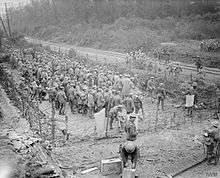
The situation was only resolved when, in January 1916, the Lancashire Brigade (by then renumbered the 154th (3rd Highland) Brigade and later became the 164th (North Lancashire) Brigade) left the division and their place was filled by original Highland battalions released by the regular divisions and by battalions of the Black Watch (Royal Highlanders) not originally in the division. Given the chance to show their mettle in July 1916, during the Battle of the Somme, they assaulted High Wood, which they attacked forcefully in the midst of a murderous field of fire without shelter. Though they failed to take the position, they had shown the fighting spirit expected of Highlanders. The division's reputation grew and they were chosen to capture the notorious fortress village of Beaumont-Hamel in November 1916, towards the end of the Somme offensive. The 51st were "Harper's Duds" no longer, now they were, according to the German nickname, "The Ladies From Hell".
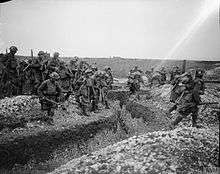
By 1917, the 51st was considered a leading assault division and was handed more and more difficult tasks, throughout the year, from Arras in April/May to the combined tank-infantry assault at Cambrai in November.
By early 1918, the division, as with numerous others in the BEF at the time, was below-strength due to losses in 1917 and the tired survivors were given a quiet part of the front line to hold. Unfortunately, the Germans had by chance chosen that location as one of the focal points for their Kaiserschlacht, the last great German assault on the West in March 1918, intended to win the war before the American Expeditionary Force (AEF) could arrive in great numbers. The neighbouring Portuguese troops bore the brunt of the initial German assault and when they started to retire from their positions and ran across the 51st's positions, they were mistaken for Germans in the poor visual conditions and the 51st opened fire on them, causing casualties. The under-strength 51st was also pushed back, but eventually held as the German offensive ebbed and flowed. The remains of the division survived the Spring battles and received replacements in time for Haig's Allied offensives of August 1918 onward, which saw the war coming to an end on 11 November 1918.
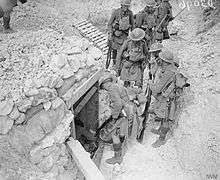
During 1918, members of the division were painted by the war artist Frederick Farrell, in France.[6]
First World War battles
Battles the division participated in the First World War included:[7]
- Battle of Festubert
- Battle of Givenchy
- Battle of the Somme
- Battle of Arras (1917)
- Third Battle of Ypres (1917)
- Battle of Cambrai (1917)
- German Spring Offensive
- Hundred Days Offensive
Order of battle
The composition of the 51st Division during World War I was as follows:[7][8]
- 1/5th (Sutherland and Caithness) Battalion, Seaforth Highlanders
- 1/6th (Morayshire) Battalion, Seaforth Highlanders
- 1/8th (Argyllshire) Battalion, Argyll and Sutherland Highlanders (from 154th Bde. April 1915)
- 1/4th Battalion, Queen's Own Cameron Highlanders (until February 1915)
- 1/6th (Renfrewshire) Battalion, Argyll and Sutherland Highlanders (from 154th Bde. April 1915 to June 1915)
- 1/6th (Banff and Donside) Battalion, Gordon Highlanders (from June 1916)
- 1/6th Battalion, Black Watch
- 1/7th (Fife) Battalion, Black Watch
- Shetland Companies, Gordon Highlanders
- 1/4th Battalion, Gordon Highlanders (until February 1915)
- 1/5th (Buchan and Formartine) Battalion, Gordon Highlanders (until February 1918)
- 1/7th (Deeside Highland) Battalion, Gordon Highlanders (until October 1918)
The original brigade comprised the following battalions until April 1915 when some of the battalions moved to the 152nd Brigade:
- 1/6th (Renfrewshire) Battalion, Argyll and Sutherland Highlanders
- 1/7th Battalion, Argyll and Sutherland Highlanders
- 1/8th (Argyllshire) Battalion, Argyll and Sutherland Highlanders
- 1/9th (Dunbartonshire) Battalion, Argyll and Sutherland Highlanders
Between 18 April 1915 and January 1916, the brigade was replaced by the Territorial Force battalions of the 164th (North Lancashire) Brigade from the 55th (West Lancashire) Division.
- 1/4th Battalion, King's Own Royal Regiment (Lancaster)
- 1/8th (Liverpool Irish) Battalion, King's Regiment (Liverpool)
- 2/5th Battalion, Lancashire Fusiliers
- 1/4th Battalion, Loyal Regiment (North Lancashire)
- 1/6th Battalion, Cameronians (Scottish Rifles)
After early 1916, the brigade contained the following battalions:
- 1/4th (Ross Highland) Battalion, Seaforth Highlanders
- 1/4th Battalion, Gordon Highlanders
- 1/9th (Highlanders) Battalion, Royal Scots
- 1/7th Battalion, Argyll and Sutherland Highlanders
Artillery
- I Highland Brigade, Royal Field Artillery (numbered CCLV (I Highland) Brigade on 15 May 1916)
- 1st Aberdeen Battery
- 2nd Aberdeen Battery
- 3rd Aberdeen Battery
- I Highland Brigade Ammunition Column
- II Highland Brigade, RFA (numbered CCLVI (II Highland) Brigade on 19 May 1916)
- Forfarshire Battery
- Fifeshire Battery
- Dundee Battery
- II Highland Brigade Ammunition Column
- III Highland (Howitzer) Brigade, RFA (numbered CCLVIII (III Highland) Brigade on 17 May 1915)
- 1st Renfrew (Howitzer) Battery
- 2nd Renfrew (Howitzer) Battery
- III Highland (Howitzer) Brigade Ammunition Column
- Highland (Fifeshire) Heavy Battery, Royal Garrison Artillery (until 5 May 1915)
- I Lowland Brigade RFA (joined 10 November 1915 from Forth Defences; renumbered CCLVII on 15 May 1916, changed to CCLX on 3 June 1916)[9]
- 1st Edinburgh Battery
- 2nd Edinburgh Battery
- Midlothian Battery
- I Lowland Brigade Ammunition Column
After reorganisation in August 1916:
- CCLV Brigade, RFA
- A, B, C, D (H) Batteries
- CCLVI Brigade, RFA
- A, B, C, D (H) Batteries
Engineers[10]
- 1st Highland Field Company, Royal Engineers (renumbered 400th (1st Highland) Field Company 3 February 1917)
- 2/2nd Highland Field Company, RE (raised after outbreak of war; renumbered 404th (2/2nd Highland) Field Company 3 February 1917)
- 3rd Durham Field Company, RE (joined 19 September 1915; transferred to 7th Division 30 January 1916)
- 2nd Highland Field Company, RE (transferred from 7th Division 31 January 1916; renumbered 401st (2nd Highland) Field Company 3 February 1917)
Pioneers
- 1/8th Battalion Royal Scots (transferred from 7th Division 19 August 1915)
Second World War
| 51st (Highland) Infantry Division | |
|---|---|
 Formation patch as worn after 1940. | |
| Active | 1939–1946 |
| Country |
|
| Branch |
|
| Type | Infantry |
| Size | Division |
| Nickname(s) | "Highway Decorators" |
| Engagements |
Battle of France Second Battle of El Alamein Sicily landings Normandy Campaign Battle of the Bulge Operation Veritable Operation Plunder |
| Commanders | |
| Notable commanders |
Victor Fortune Alan Cunningham Neil Ritchie Douglas Wimberley Tom Rennie |
The 51st (Highland) Infantry Division was initially commanded by Major-General Victor Fortune and formed part of the British Expeditionary Force in France during the first few months of World War II. With the capture of two of its brigades in France the division effectively ceased to exist. The 9th (Highland) Infantry Division, the 2nd Line duplicate of the 51st, was renumbered as the 51st and subsequently served in the North African Campaign. From there it went to Sicily before returning to France as part of the invasion of Northern Europe.
France 1940
The division was mobilised on 24 August 1939, due to the worsening situation with Nazi Germany. After three years of training under Major-General Fortune's command, the 51st (Highland) Infantry Division departed from Southampton and disembarked at Le Havre in mid-January 1940.[11] On 28 January it came under command of II Corps of the British Expeditionary Force (BEF), under Lieutenant-General Michael Barker, which also included the 1st and 2nd Infantry Divisions, both Regular Army formations.
Throughout February and March the 51st Division saw a major reorganisation, in line with the official policies of the BEF, and some units of the division were replaced by Regular Army formations which was, in theory, to strengthen the inexperienced Territorial divisions. As an example, the 23rd Field Regiment of the Royal Artillery, a Regular Army unit, arrived, replacing the 76th (Highland) Field Regiment, Royal Artillery which transferred to the 3rd Infantry Division.[12]
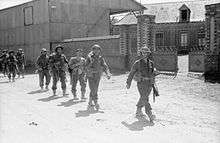
On 22 April 1940 the 51st Division was detached from the rest of the BEF to come under command of the French Third Army. The division was stationed in front of the Ouvrage Hackenberg fortress of the Maginot Line and had thus escaped being encircled with the rest of the BEF during the Battle of France where it was forced to retreat to Dunkirk, where it was evacuated. It was then pulled back to a new line roughly along the River Somme, where it was attached to the French Tenth Army. For some time, it was forced to hold a line four times longer than that which would normally be expected of a division. The 51st was attacked very heavily over 5–6 June with the major attack initially falling on the 7th Battalion, Argyll and Sutherland Highlanders before the other battalions of the 154th Brigade were enveloped. The Argylls' losses were heavy, the worst day for casualties in their history. Being overwhelmed, 154th Brigade was forced to retire to the west. During this period, the 154th Brigade was detached to form "Arkforce" and was able to escape the German drive into central France and Normandy.[13] However, the 152nd and 153rd Brigades were trapped, with French troops under General Ihler, at Saint-Valery-en-Caux, and surrendered on 12 June, along with the division's commander. Major-General Fortune was one of the most senior British officers taken prisoner in World War II. He was knighted by King George VI after the war.[14] From the British point of view, the defeat of the 51st (Highland) Division was the end of the Allied resistance during the battle of France.[14]
More than 10,000 members of the 51st (Highland) Division were taken prisoner at St Valery.[15] They were marched to Germany, via Belgium, following the route over which the Germans had advanced against them. Their destination was Stalag XX-A at Toruń,about 120 miles (190 km) north-west of Warsaw. Some were loaded into canal barges for part of their journey, but all eventually travelled by train in cattle wagons.
There were some notable escapes, mostly in the early stages of the march. Of the 290 British Army POW escapers who had returned to Britain by the end of June 1941, 134 were members of the 51st (Highland) Division.[15]
As other camps were brought into operation, a large proportion of the POWs were transferred – most to Stalag XX-B at Malbork and Stalag 344 at Lambinowice, but with small numbers in many other camps. Early in 1945, the Russian Army had advanced close to these camps, so the POWs were involved in the Long March. Those from Stalag XX-A marched around 450 miles (720 km) in the depths of winter to Stalag XIB/357 at Bad Fallingbostel on the Lüneburg Heath, north of Hanover.
On 12 June 2010, veterans of the 51st (Highland) Division attended a commemorative ceremony for the 70th Anniversary of the battle at Saint-Valéry-en-Caux.[16]

In August 1940, the 9th (Highland) Infantry Division, the 2nd Line TA duplicate of the old 51st Division, was converted into the new 51st Division, with the 26th and 27th Infantry Brigades redesignated as 152nd and 153rd Infantry Brigade, and the 28th Infantry Brigade being merged with the severely understrength 154th Infantry Brigade. Almost two years of home defence followed on the south coast of England and north-east coast of Scotland against a potential German invasion.[17][18]
The Mediterranean and Middle-East
Arriving in North Africa in June 1942, the new 51st (Highland) Division, now commanded by Major-General Douglas Neil Wimberley, who had assumed command in June of the previous year, experienced its first fighting at the Second Battle of El Alamein (October–November 1942). It then played a major part in Operation Lightfoot, where it was in the centre of the Northern Push, between the 9th Australian Division and the 2nd New Zealand Division. It faced the German 21st Panzer Division and some Italian units. Initially unsuccessful during Lightfoot, the minefields it cleared were key in achieving a breakout during Operation Supercharge.
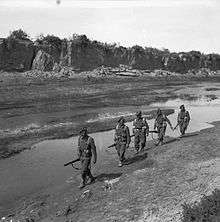
Subsequently the 51st Division was involved in many battles of the Tunisia Campaign, including the battle of Wadi Akarit, in early April 1943, and took part in the frontal assault on strongpoints guarded by deep minefields, where it was on the far right of the line. The Commanding Officer (CO) of the 7th Battalion, Argyll and Sutherland Highlanders, Lieutenant Colonel Lorne MacLaine Campbell, was awarded the Victoria Cross for his leadership during the battle. Throughout the fighting in North Africa the division served under the command of the British Eighth Army, under General Bernard Montgomery.
Later, in July 1943, the 51st (Highland) Division took part in the Allied invasion of Sicily, codenamed Operation Husky, suffering comparatively light casualties in the short campaign. The division was then recalled from the Eighth Army and returned to the United Kingdom, on the wishes of the Army's old commander, General Montgomery, together with the veteran 7th Armoured and 50th (Northumbrian) Infantry Divisions, to prepare for the opening of the Second Front in June 1944. Montgomery later commented on the 51st "Of the many fine divisions that served under me in the Second World War, none were finer than the Highland Division. It was the only infantry division in the armies of the British Empire that accompanied me during the whole of the long march from Alamein to Berlin."

When a group of recuperating wounded soldiers of the 51st returned from their North African hospital to rejoin the division in Sicily, they were instead split up and ordered to various units and formations, mainly the British 46th Infantry Division which had suffered heavy casualties during the Salerno landings, totally unrelated to the 51st Division or its component regiments. Some soldiers of the division regarded this as administrative high-handedness and refused to follow these orders, and the result was the Salerno Mutiny. The mutineers were distributed to various units regardless, while ringleaders were sentenced to death (the sentences were later commuted and finally quashed).
Battle of Normandy

Most of the 51st landed in Normandy as part of Operation Overlord on 7 June 1944, a day after D-Day, as part of British I Corps, under Lieutenant-General John Crocker. After spending a brief period supporting the 3rd Canadian Infantry Division, it was sent across the River Orne, and spent two months supporting the 6th Airborne Division in its bridgehead. During this period it fought many difficult actions at places such as Breville (11–12 June) and Colombelles (11 July). The 51st (Highland) Division's performance in Normandy was, overall, considered disappointing, particularly by General Montgomery, now the Commander-in-Chief (C-in-C) of the Allied land forces in Normandy, who stated in a telegram to Field Marshal Sir Alan Brooke, the Chief of the Imperial General Staff (CIGS, the professional head of the British Army), that the division "had failed every mission it was given".[19] This led to the replacement of its GOC, Major-General Charles Bullen-Smith, with Major-General Tom Rennie, who had served with the division in France, North Africa and Sicily before being elevated to command of the British 3rd Infantry Division for the Normandy invasion.[20]
On 1 August 1944 the division, along with the rest of British I Corps, became part of the newly activated Canadian First Army. The division fought alongside this army in Operation Totalize, before advancing to Lisieux. It then continued east over the River Seine and headed, on General Montgomery's orders[21] for Saint-Valéry-en-Caux, the scene of the division's surrender in June 1940. The division's massed pipes and drums played in the streets of the town, and a parade included veterans of the 1940 campaign in France who were with the 51st Division in 1944. A similar event occurred at Dieppe when it was liberated by the 2nd Canadian Infantry Division. Leaving Saint Valéry, the 51st Division was engaged in Operation Astonia, the battle for the French port of Le Havre, in September 1944.
After Normandy
After the successful capture of the town of Le Havre, the division went on to take part in the Battle of the Scheldt in October 1944, finally passing into reserve and garrisoning the Meuse River during the Battle of the Bulge, now as part of XXX Corps, under Lieutenant General Brian Horrocks. It was not involved in heavy fighting during the early stages of the battle and was deployed as a stopgap in case the Germans broke through.

In January 1945, the division, along with the rest of XXX Corps, helped to cut off the northern tip of the German salient, linking up with the U.S. 84th Infantry Division at Nisramont on 14 January.[22] Following this, the division was involved in Operation Veritable, the clearing of the Rhineland. In late March the 51st took part in Operation Plunder, the crossing of the River Rhine, where the GOC, Major General Tom Rennie, was killed by enemy mortar fire. He was replaced by Major General Gordon Holmes Alexander MacMillan, a very highly experienced and competent commander who had previously been the GOC of the 49th (West Riding) Infantry Division. The division advanced through Germany and ended the war in the Bremerhaven area of Northern Germany. During the North-West Europe campaign the 51st (Highland) Division had suffered a total of 19,524 battle casualties.[23]
Order of battle 1939–1940
The original 51st Infantry Division was constituted as follows until captured 12 June 1940:[24][25]
152nd Infantry Brigade (captured 12 June 1940)[26]
- 4th Battalion, Seaforth Highlanders
- 6th Battalion, Seaforth Highlanders (left 3 March 1940)
- 4th Battalion, Queen's Own Cameron Highlanders
- 152nd Infantry Brigade Anti-Tank Company (formed 28 January 1940)
- 2nd Battalion, Seaforth Highlanders (from 30 March 1940)
153rd Infantry Brigade (captured 12 June 1940)[27]
- 4th Battalion, Black Watch (Royal Highland Regiment)
- 5th Battalion, Gordon Highlanders
- 6th Battalion, Gordon Highlanders (left 7 March 1940)
- 153nd Infantry Brigade Anti-Tank Company (formed 18 November 1939)
- 1st Battalion, Gordon Highlanders (from 7 March 1940)
- 1st Battalion, Black Watch (Royal Highland Regiment) (from 5 June 1940)
154th Infantry Brigade (escaped 15 June 1940)[28]
- 6th Battalion, Black Watch (Royal Highland Regiment) (left 4 March 1940)
- 7th Battalion, Argyll and Sutherland Highlanders
- 8th Battalion, Argyll and Sutherland Highlanders
- 154th Infantry Brigade Anti-Tank Company (formed 18 November 1939)
- 1st Battalion, Black Watch (Royal Highland Regiment) (from 4 March, left 5 June 1940)
Divisional Troops
- 1st Fife and Forfar Yeomanry (Reconnaissance regiment, left 29 March 1940)
- 1st Lothians and Border Horse (Divisional cavalry regiment from 29 March, captured 12 June 1940)
- 75th (Highland) Regiment, Royal Artillery (captured 12 June 1940)
- 76th (Highland) Regiment, Royal Artillery (left 5 March 1940)
- 77th (Highland) Regiment, Royal Artillery (left 19 February 1940)
- 17th Field Regiment, Royal Artillery (from 19 February, captured 12 June 1940)
- 23rd Field Regiment, Royal Artillery (from 5 March 1940, captured 12 June 1940)
- 51st (West Highland) Anti-Tank Regiment, Royal Artillery (captured 12 June 1940)
- 236th (City of Aberdeen) Field Company, Royal Engineers (captured 12 June 1940)
- 237th (City of Dundee) Field Company, Royal Engineers (captured 12 June 1940)
- 238th (County of Renfrewshire) Field Company, Royal Engineers (left 29 February 1940)
- 26th Field Company, Royal Engineers (from 28 February, captured 12 June 1940)
- 239th (City of Aberdeen) Field Park Company, Royal Engineers
- 51st (Highland) Divisional Signals Regiment, Royal Corps of Signals
Also attached were the following:
- 1st Battalion, Princess Louise's Kensington Regiment, Middlesex Regiment (Machine Gun Battalion)
- 7th Battalion, Royal Northumberland Fusiliers (Machine Gun Battalion)
- 7th Battalion, Royal Norfolk Regiment (Infantry Sappers)
- 6th Battalion, Royal Scots Fusiliers (Infantry Sappers)
Order of battle 1940–1945
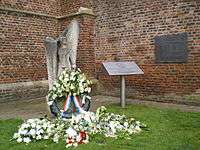
The reformed 51st Infantry Division was constituted as follows:[29]
152nd Infantry Brigade (formerly 26th Infantry Brigade)[26]
- 2nd Battalion, Seaforth Highlanders
- 4th/5th Battalion, Seaforth Highlanders (left 4 April 1941)
- 7th Battalion, Seaforth Highlanders (left 23 August 1940)
- 5th Battalion, Queen's Own Cameron Highlanders
- 152nd Infantry Brigade Anti-Tank Company (formed 1 September 1940, disbanded 14 December 1941)
- 5th Battalion, Seaforth Highlanders (from 5 April 1941)
153rd Infantry Brigade (formerly 27th Infantry Brigade)[30]
- 5th Battalion, Black Watch (Royal Highland Regiment)
- 7th Battalion, Gordon Highlanders (left 7 November 1939)
- 9th Battalion, Gordon Highlanders (left 2 September 1940)
- 1st Battalion, Gordon Highlanders
- 153rd Infantry Brigade Anti-Tank Company (formed 1 September 1940, disbanded 1 January 1941)
- 5th/7th Battalion, Gordon Highlanders (from 21 October 1940)
154th Infantry Brigade (formerly 28th Infantry Brigade)[31]
- 7th Battalion, Black Watch (Royal Highland Regiment) (left 21 August 1945)
- 7th/10th Battalion, Argyll and Sutherland Highlanders (became 7th Battalion 30 September 1942)
- 11th Battalion, Argyll and Sutherland Highlanders (left 22 September 1941)
- 2nd Battalion, Seaforth Highlanders (left 4 September 1940)
- 154th Infantry Brigade Anti-Tank Company (formed 1 September 1940, disbanded 2 January 1941)
- 1st Battalion, Black Watch (Royal Highland Regiment) (from 24 October 1940)
Divisional Troops
- 2nd Derbyshire Yeomanry (Reconnaissance regiment, from 20 January 1944)
- 1/7th Battalion, Middlesex Regiment (from 20 November 1941, joined as Machine Gun Battalion, became Support Battalion 10 December 1943, reverted to MG Battalion 28 February 1944)
- 51st Battalion, Reconnaissance Corps (formed 8 January 1941, became 51st Regiment 6 June 1942, left 26 November 1942)
- 126th Field Regiment, Royal Artillery
- 127th Field Regiment, Royal Artillery
- 128th Field Regiment, Royal Artillery
- 61st Anti-Tank Regiment, Royal Artillery
- 40th Light Anti-Aircraft Regiment, Royal Artillery (from 1 May 1942)
- 274th Field Company, Royal Engineers
- 275th Field Company, Royal Engineers
- 276th Field Company, Royal Engineers
- 239th Field Park Company, Royal Engineers
- 16th Bridging Platoon, Royal Engineers (formed 19 December 1943)
- 51st (Highland) Divisional Signals Regiment, Royal Corps of Signals
Legacy
A specific memorial to the division exists at the Beaumont-Hamel Newfoundland Memorial site on the Somme, by the sculptor George Henry Paulin. A further memorial in the form of a sculpture by Alan Herroit was unveiled in May 1995 on the North Inch in Perth, Scotland. As well as commemorating 50 years of peace in Europe, the sculpture depicts a Highlander being greeted by a young Dutch girl during the liberation of Holland by the 51st. A twin casting was unveiled in The Netherlands in 1994.
Music
- "The 51st (Highland) Division's Farewell to Sicily", a folk song written by Hamish Henderson, a former officer who served in the 51st Division during the Sicilian campaign. It has been recorded by a number of folk singers, including Dick Gaughan.
- "The Beaches of St. Valery", performed by the Battlefield Band. Written by Davy Steele, it tells the story of the 51st Division's struggle to reach Saint-Valéry-en-Caux in 1940 only to find that no ships had been sent to evacuate them.
- "The Old Boys", performed by the Scottish group Runrig, who sing in both English and Gaelic. The song which first appeared on the album Recovery (1981) and was reprised on Protera (2003) speaks of the declining numbers of Gaelic speaking members of the 51st who fought at St Valery.
- "Farewell, 51st, farewell!", a folk song written by Andy Stewart, about scrapping of the 51st Division, but indicates that they will never be forgotten, as the lyrics say "On the glory road of fame, there is honour tae your name. Farewell 51st, Farewell."
- "The 51st Highland Division", a 4/4 march composed by Pipe Major Donald Mac leod.[32]
- "The 51st Highland Division Farewell", a 2/4 march composed by Dr. Charles Bannatyne.[33]
- "The 51st Highland Division at Wadi Akarit", a 2/4 march composed by W. Mac Donald.[34]
Dance
- "The Reel of the 51st Division" was written in the Laufen PoW camp by soldiers captured at St Valery. It was the very first modern Scottish Country Dance published by the Royal Scottish Country Dance Society. The original tune written in Laufen has been superseded by the traditional reel "The Drunken Piper" and the dance was re-cast from its original form involving a longwise set of ten men to the more usual four couple set. The original ten-man version is still danced in some parts.
The dance was published in the first post-World War II edition (Book Thirteen) of "The Scottish Country Dance Book".
Victoria Cross recipients
- Sergeant William Gosling, Royal Field Artillery, 3rd Wessex Brigade, World War I
- Private George McIntosh, 1/6th Battalion, Gordon Highlanders, World War I
- Sergeant Alexander Edwards, 1/6th Battalion, Seaforth Highlanders, World War I
- Lance Corporal Robert McBeath, 1/5th Battalion, Seaforth Highlanders, World War I
- Sergeant John Meikle, 4th Battalion, Seaforth Highlanders, World War I
- Lieutenant William Davidson Bissett, 1/6th Battalion, Argyll and Sutherland Highlanders, World War I
- Lieutenant Colonel Lorne MacLaine Campbell, 7th Battalion, Argyll and Sutherland Highlanders, World War II
Commanders
- Major-General Richard Bannatine-Allason: August 1914-September 1915
- Major-General George M. Harper: 25. September 1915-10. March 1918
- Major-General George T.C. Carter-Campbell: 11. March 1918- June 1919
- Major-General Ewen G. Sinclair-Maclagan: June 1919-June 1923
- Major-General Sir Archibald B. Ritchie: June 1923-June 1927
- Major-General Sir William M. Thomson: June 1927-June 1931
- Major-General Sir James L.G. Burnett of Leys, Bt.: June 1931-June 1935
- Major-General W. Douglas S. Brownrigg: June 1935-January 1938
- Major-General Victor Fortune: January 1938 –12 June 1940 (captured)
- Major-General Sir Alan Cunningham: 7 August 1940 – 7 October 1940
- Major-General Sir Neil M. Ritchie: 7 October 1940 – 11 June 1941
- Major-General. Douglas N. Wimberley: 11 June 1941 – 8 August 1943
- Major-General Charles D. Bullen-Smith: 8 August 1943 – 26 July 1944
- Major-General Thomas G. Rennie: 26 July 1944 – 23 March 1945 (killed in action)
- Major-General Gordon H. MacMillan: 23 March 1945 – 28 May 1945
- Major-General James Cassels: 28 May 1945 – March 1946 [35]
- Major-General Colin M. Barber: 1946-May 1949
- Major-General Robert K. Arbuthnott: May 1949-November 1952
- Major-General James Scott-Elliot: November 1952-March 1956
- Major-General Edward C. Colville: March 1956-March 1959
- Major-General Frederick C.C. Graham: March 1959-March 1962
See also
- List of British divisions in World War I
- List of British divisions in World War II
- British Army Order of Battle (September 1939)
References
- ↑ Beckett 2008, 169.
- ↑ Graham Watson, The Territorial Army, 1947 Archived 5 December 2013 at the Wayback Machine., v1.0, 10 March 2002, www.orbat.com
- ↑ Beckett 2008, 178.
- ↑ Beckett 2008, 180.
- ↑ Beckett 2008, 183, 185, and regiments.org (archive), Highland, 1905–1995.
- ↑ Munro, Neil (1920). "The 51st (Highland) division; war sketches". Internet Archive. Retrieved 9 May 2015.
- 1 2 Becke, pp. 101–7.
- ↑ 51 Division at Long, Long Trail
- ↑ Becke, p. 111.
- ↑ Richard A. Rinaldi, Royal Engineers, World War I at Orbat.com
- ↑ Delaforce, p.10
- ↑ http://www.britishmilitaryhistory.co.uk/webeasycms/hold/uploads/bmh_document_pdf/51_Infantry_Division__1939_.pdf
- ↑ http://www.britishmilitaryhistory.co.uk/webeasycms/hold/uploads/bmh_document_pdf/51-Infantry-Division-1940-.pdf
- 1 2 Heroes of St. Valery
- 1 2 Saul David, Churchill's Sacrifice of the Highland Division, France 1940, ISBN 1-85753-378-X
- ↑ Council supports Saint Valery en Caux Battle commemorations The Highland Council, 11 June 2010
- ↑ Salmond, pp. 19–25
- ↑ Gorle, pp. 10–16
- ↑ Doherty, p.167
- ↑ Delaforce, p.145
- ↑ Doherty, p.184
- ↑ Delaforce, pp. 196–7
- ↑ Salmond, p.273
- ↑ Joslen, p. 83.
- ↑ Doherty, pp. 277–78
- 1 2 Joslen, p. 337.
- ↑ Joslen, p. 339.
- ↑ Joslen, p. 340.
- ↑ Joslen, p.83.
- ↑ Joslen, p. 274.
- ↑ Joslen, pp. 275, 340.
- ↑ Queen's Own Highlanders Caber Feidh collection of bagpipe music (Book 2), Patterson's Publications, London
- ↑ Logan's Complete Collection of Highland Bagpipe Music, Tutor Number Eight
- ↑ Queen's Own Highlanders standard settings of bagpipe music, Patterson's Publications, London
- ↑ See Salmond, The Story of the 51st Highland Division
Bibliography
- Maj A.F. Becke,History of the Great War: Order of Battle of Divisions, Part 2a: The Territorial Force Mounted Divisions and the 1st-Line Territorial Force Divisions (42–56), London: HM Stationery Office, 1935/Uckfield: Naval & Military Press, 2007, ISBN 1-847347-39-8.
- Ian F.W. Beckett, 'Territorials: A Century of Service,' First Published April 2008 by DRA Printing of 14 Mary Seacole Road, The Millfields, Plymouth PL1 3JY on behalf of TA 100, ISBN 978-0-9557813-1-5,
- Bewsher, F. W. (1921). The History of the 51st (Highland) Division 1914–1918 (N & M Press 2001 ed.). London: Blackwood. ISBN 1-84342-108-9. Retrieved 14 September 2014.
- Delaforce, Patrick, Monty's Highlanders: The Story of the 51st Highland Division Pen & Sword, 2007. ISBN 1-84415-512-9
- Doherty, Richard, None Bolder: The History of the 51st Highland Division in the Second World War Spellmount, 2006. ISBN 1-86227-317-0
- Gorle, Richmond "The Quiet Gunner" Alamein to the Rhine with the Scottish Divisions, Pen and Sword 2011 ISBN 978-1-84884-540-4
- Linklater, Eric The Highland Division. HMSO, 1942. No ISBN.
- Salmond, J.B. The Story of the 51st Highland Division. Wm Blackwood & Sons, 1953. No ISBN.
- Joslen, Lt-Col H.F. (2003) [1st pub. HMSO:1960]. Orders of Battle: Second World War, 1939–1945. Uckfield: Naval and Military Press. ISBN 978-1-84342-474-1.
External links
- www.51hd.co.uk - The Official Website of the 51 Highland Division
- The British Army in the Great War: The Long, Long Trail
- The Forgotten 51st
- The Forgotten Heroes of World War 2 by Robert Beesley
- Remember the 51st (Highland) Division at Saint-Valéry-en-Caux
- Orbat.com
- Timeline history of 1940 surrender with photos of the memorial at Veules-les-Roses
_Division_Insignia.png)